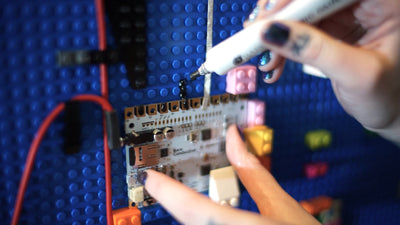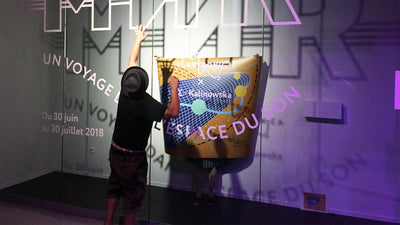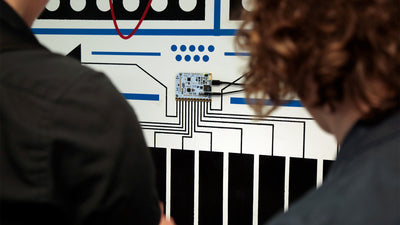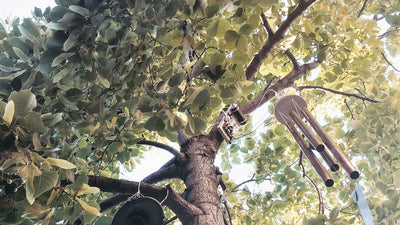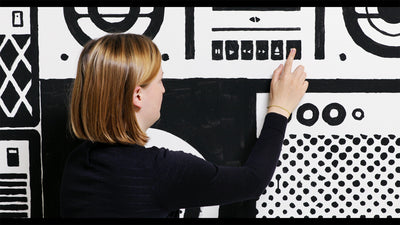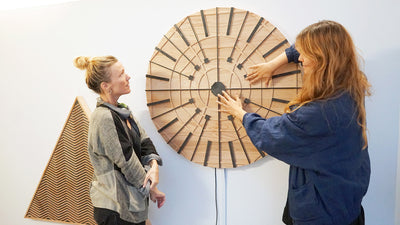1000 Voices for Yazidis - Giving A Voice Through Interactive Art

A powerful interactive installation by Didem Gezginci, which gives a voice to the Yazidi woman captured by ISIS.
The ability to create artwork that can be interacted with by an audience, creates a powerful and meaningful experience. Often, allowing for messages that an artist or designer is trying to convey, to stand out even clearer. '1000 Voices for Yazidis' is an interactive sound installation by artist Didem Gezginci. She spoke to us about how she used touch and sound to give a voice to the Yazidi woman captured by ISIS, given refuge in Germany.
Didem is an interdisciplinary designer and artist based in Germany. Using the Touch Board, she created interactive walk-in sculptures for a social project as part of her studies at the University of Applied Sciences Konstanz (Germany).
The Exhibition space “1000 Voices for Yazidis” was a project created by Masters Communication Design students at the University of Applied Sciences in Konstanz (Germany). The students were working with Yazidi women who were captured by ISIS and brought to Germany by the government of the federal state of Baden-Wurttemberg as refugees. One of the refugees was the cousin of Nadja Murad, who was named for the Nobel Prize because of her engagement in this matter. Together with Amal Clooney she went to the UN in New York and gave Jazidi people a voice.

Under the patronage of the Ministry of State Baden-Württemberg (Germany), the exhibition “1000 Voices for Yazidis” was created to red-flag the genocide committed by the Daesh against the Yazidis in North Iraq. So-called ISIS aimed at the extinction of Yazidi culture through killing men and enslaving women and children. 1000 women and children in need of protection are housed in Germany to recover from their traumas.
The main goal of the project was to give a voice to the victims, but also protect their privacy, which was one of the biggest issues the designers faced when creating the exhibition. They were not allowed to show the Yazidi women, mention their real names or give too much information about them because they were still persecuted.
So how did they make a personal story accessible without mentioning the individuals themselves?
During workshops with these women, they figured out the message they wanted to give and what their hopes and dreams were for the future. First, the refugees wanted to initiate financial help to the rescued Yazidis in the refugee camp in northern Iraq and second, explain their religion and culture which was often misunderstood as satanism. So the students decided to design an exhibition that explained the Yazidi religion and culture, raised awareness of the genocide and allowed them to sell artwork they produced with the women and donate the proceeds to the cause.
Didem's work for the installation space was the core of the exhibition: The room of “Lalish” – an abstraction sound sculpture space based on the sacral chapel of the Yazidis based in North-Iraq. Where she turned the characteristic towers of the chapel into wooden interactive audio sculptures. She interviewed the Yazidi women about their misunderstood religion and then recorded their voices in their own language and added a german translation overlay to the piece of art.
To create a soundscape the audience could touch any painted sheet of a tower, the sound of the Yazidi women could be heard out of the wooden sheets. Some towers also played Yazidi music sang by women or nature sounds like wind, water or chirps of birds and crickets, because the Yazidi religion is nature-based.
Regardless of whether there was just one person or a whole group exploring the towers at the same time, every single sound combination created a sacral acoustic and echoed through the whole exhibition area over 4 floors.
The 2-meter tall towers were painted with Electric Paint which was connected to the Touch Board to control the sound. Didem used a vibration speaker which triggered the sound through vibration to the sculpture to make the sound come out of the wooden sheets directly. Enabling her to create a haunting experience through resonating sculptures that you could also walk in.
The pattern she used for the art was created by Yazidi women and design students during the workshops. The pattern was first plotted on foil and then stencilled on the wooden sheets. It was challenging to create different and complex oriental patterns which ensured a working circuit.
She had to correct some patterns afterwards manually with a thin brush. The biggest challenge creating the interactive artwork was finding the right value for the capacitive sensing distance. The pattern had a big surface and some were too thin or irregular or perhaps were too near to each other, so they sometimes activated each other by themselves. Her tests took a few weeks and involved several electronics engineers to solve the problem.
In the end, they couldn’t find a perfect solution for that, however, it was then decided it could be interesting too, the towers would be able to grab the visitors attention by themselves.
Even if there was nobody touching the towers, sometimes a sculpture would become independent and play some sounds on its own. The supervisory staff of the exhibition told her it was like there were “kind of living and interacting sculptures from time to time“ which astonished the visitors too.
The Yazidi women were invited to the opening event and got touched by the atmosphere of the “Lalish” room. They started to make knots in scarfs they put on the towers – a Yazidi ritual to make wishes come true.
The creation (concept, prototyping, realisation) of Didem's sculptures took about 3 months of permanent work "I did at some points feel I was burning the candle at both ends. But it was really fun to explore the Touch Board and Electric Paint. I’m looking forward to my next idea for an interactive art installation and hope to find an opportunity for a new exhibit".
Images & Videos: Maunel Fleig
We love it when you share your projects! Post your project on Instagram, YouTube, Vimeo, or Twitter, and make sure to tag @bareconductive or use #bareconductive. You can also send your videos and photos to info@bareconductive.com. Submit your project for a chance to be featured and you'll also receive 20% discount.


